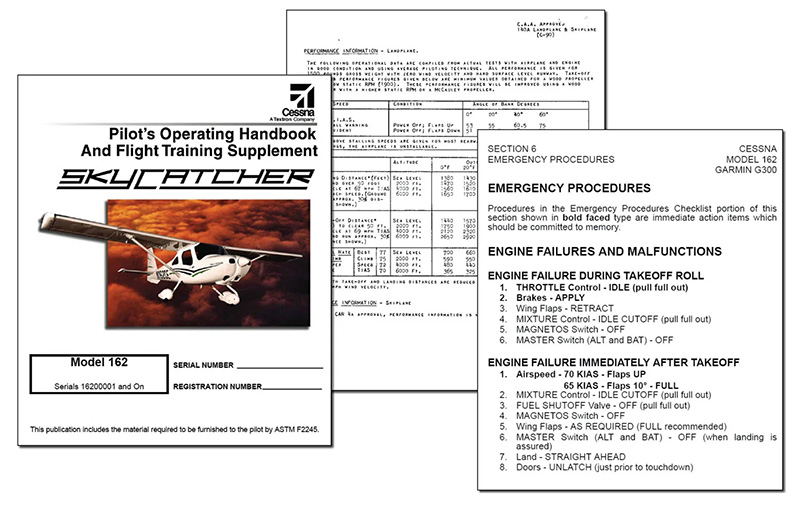Pilot's Operating Handbook (POH): Difference between revisions
Jump to navigation
Jump to search
No edit summary |
No edit summary |
||
| (One intermediate revision by the same user not shown) | |||
| Line 1: | Line 1: | ||
[[File:Pilot's_Operating_Handbook_(POH).jpg|thumb|right|Sample pages from the Cessna SkyCatcher POH]] | [[File:Pilot's_Operating_Handbook_(POH).jpg|thumb|right|Sample pages from the Cessna SkyCatcher POH|427x427px]] | ||
The '''Pilot's Operating Handbook (POH)''', also known as the '''Airplane Flight Manual (AFM)''', is a critical document, developed by the aircraft manufacturer, that provides pilots with all the necessary information to operate a specific aircraft safely and legally. | The '''Pilot's Operating Handbook (POH)''', also known as the '''Airplane Flight Manual (AFM)''', is a critical document, developed by the aircraft manufacturer, that provides pilots with all the necessary information to operate a specific aircraft safely and legally. | ||
| Line 25: | Line 25: | ||
* The POH has evolved over time, reflecting advancements in aircraft technology and aviation regulations. | * The POH has evolved over time, reflecting advancements in aircraft technology and aviation regulations. | ||
* Modern POHs are often more detailed and comprehensive than their predecessors, providing pilots with a wealth of information to ensure safe and efficient flight operations. | * Modern POHs are often more detailed and comprehensive than their predecessors, providing pilots with a wealth of information to ensure safe and efficient flight operations. | ||
Latest revision as of 09:12, 5 April 2025

The Pilot's Operating Handbook (POH), also known as the Airplane Flight Manual (AFM), is a critical document, developed by the aircraft manufacturer, that provides pilots with all the necessary information to operate a specific aircraft safely and legally.
Here's a more detailed historical and functional overview:
Historical Context:
- Prior to the widespread adoption of POHs, manufacturers often relied on Civil Aeronautics Administration (CAA) Form 309 to outline operating limitations for older or experimental aircraft.
- The CAA Form 309 listed key speeds and RPM limitations, serving as a precursor to the modern POH.
Purpose and Content:
- Legal Document: The POH is a legal document required by the FAA, and each aircraft has its own specific POH.
- Operational Information: The POH contains critical information, including operating limitations (e.g., speed, weight, altitude restrictions), performance charts (e.g., takeoff and landing distances, climb rates), and procedures for normal and emergency operations.
- Aircraft-Specific: The POH is tailored to a particular aircraft model and must be kept in the aircraft with the tail number of the airplane.
- Common Structure: POHs follow a common structure across manufacturers, ensuring pilots can easily find the information they need.
- Checklists: The POH includes checklists for preflight, takeoff, landing, and various abnormal situations.
Importance for Pilots:
- Familiarity: Pilots must be thoroughly familiar with their aircraft's POH, including limitations, performance characteristics, and procedures.
- Safe Operation: The POH is essential for safe and legal operation of the aircraft, ensuring pilots stay within the aircraft's operating parameters.
- Emergency Procedures: The POH provides guidance for handling various emergencies, helping pilots make informed decisions in critical situations.
Evolution:
- The POH has evolved over time, reflecting advancements in aircraft technology and aviation regulations.
- Modern POHs are often more detailed and comprehensive than their predecessors, providing pilots with a wealth of information to ensure safe and efficient flight operations.
